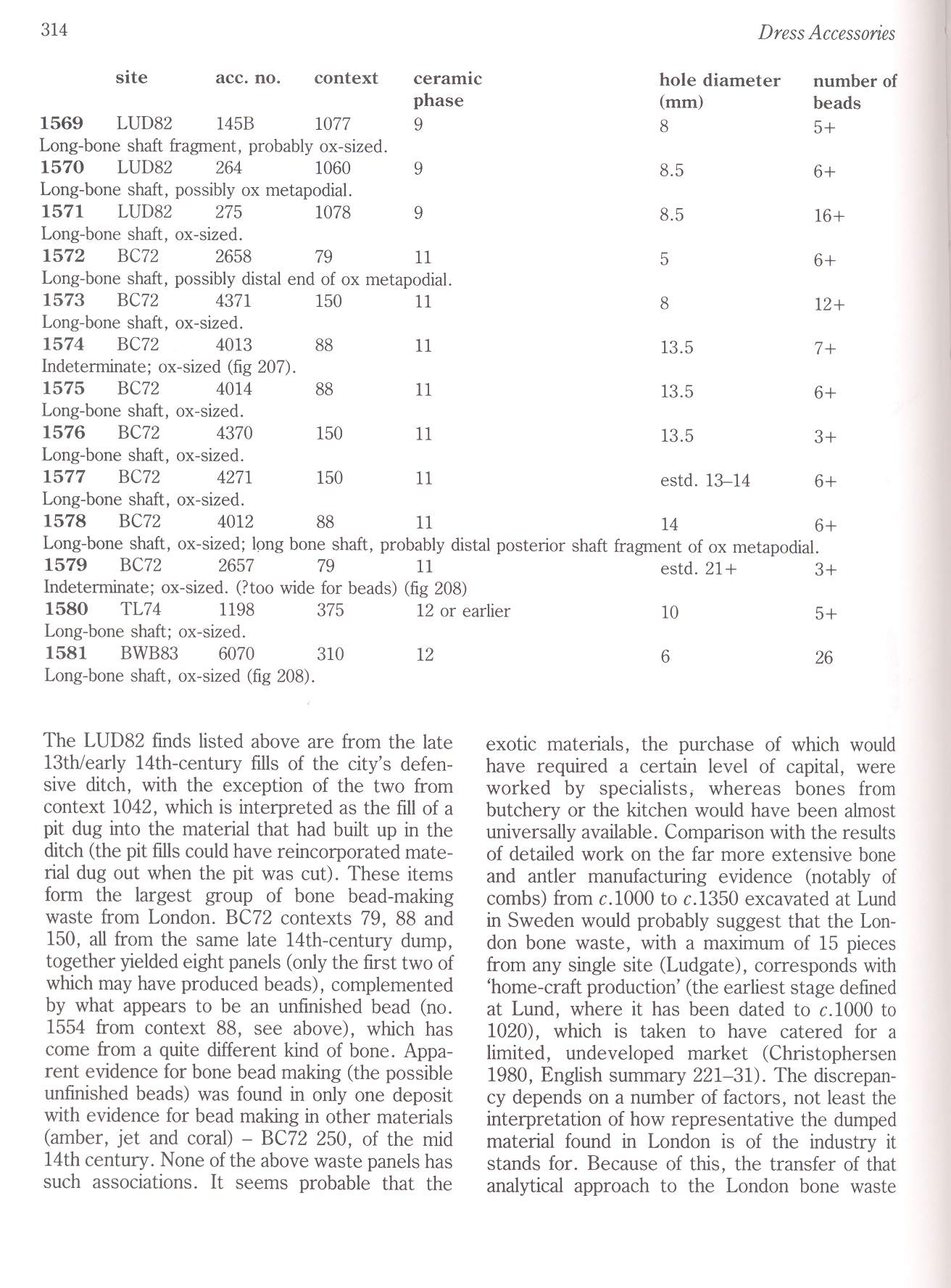341 (27)

314
Dress Accessońes
|
site acc. no. |
context |
ceramic |
hole diameter |
number of |
|
phase |
(mm) |
beads | ||
|
1569 LUD82 145B |
1077 |
9 |
8 |
5+ |
|
Long-bone shaft fragment, probably ox-sized. | ||||
|
1570 LUD82 264 |
1060 |
9 |
8.5 |
6+ |
|
Long-bone shaft, possibly ox metapodial. | ||||
|
1571 LUD82 275 Long-bone shaft, ox-sized. |
1078 |
9 |
8.5 |
16+ |
|
1572 BC72 2658 |
79 |
11 |
5 |
6+ |
|
Long-bone shaft, possibly distal end of ox metapodial. | ||||
|
1573 BC72 4371 Long-bone shaft, ox-sized. |
150 |
11 |
8 |
12+ |
|
1574 BC72 4013 |
88 |
11 |
13.5 |
7+ |
|
Indeterminate; ox-sized (fig 207). 1575 BC72 4014 |
88 |
11 |
13.5 |
6+ |
|
Long-bone shaft, ox-sized. 1576 BC72 4370 |
150 |
11 |
13.5 |
3+ |
|
Long-bone shaft, ox-sized. 1577 BC72 4271 Long-bone shaft, ox-sized. |
150 |
11 |
estd. 13-14 |
6+ |
|
1578 BC72 4012 |
88 |
11 |
14 |
6+ |
|
Long-bone shaft, ox-sized; long bonę shaft, probably distal posterior shaft fragment of ox metapodial. | ||||
|
1579 BC72 2657 |
79 |
11 |
estd. 21 + |
3+ |
|
Indeterminate; ox-sized. (?too wide for beads) (fig 208) | ||||
|
1580 TL74 1198 Long-bone shaft; ox-sized. |
375 |
12 or earlier |
10 |
5+ |
|
1581 BWB83 6070 |
310 |
12 |
6 |
26 |
Long-bone shaft, ox-sized (fig 208).
The LUD82 finds listed above are from the late 13th/early 14th-century fills of the city’s defen-sive ditch, with the exception of the two from context 1042, which is interpreted as the fili of a pit dug into the materiał that had built up in the ditch (the pit fills could have reincorporated materiał dug out when the pit was cut). These items form the largest group of bonę bead-making waste from London. BC72 contexts 79, 88 and 150, all from the same late 14th-century dump, together yielded eight panels (only the first two of which may have produced beads), complemented by what appears to be an unfinished bead (no. 1554 from context 88, see above), which has come from a ąuite different kind of bonę. Appa-rent evidence for bonę bead making (the possible unfinished beads) was found in only one deposit with evidence for bead making in other materials (amber, jet and coral) - BC72 250, of the mid 14th century. Nonę of the above waste panels has such associations. It seems probable that the exotic materials, the purchase of which would have required a certain level of Capital, were worked by specialists, whereas bones from butchery or the kitchen would have been almost universally available. Comparison with the results of detailed work on the far morę extensive bonę and antler manufacturing evidence (notably of combs) from c.1000 to c.1350 excavated at Lund in Sweden would probably suggest that the London bonę waste, with a maximum of 15 pieces from any single site (Ludgate), corresponds with ‘home-craft production' (the earliest stage defined at Lund, where it has been dated to c.1000 to 1020), which is taken to have catered for a limited, undeveloped market (Christophersen 1980, English summary 221-31). The discrepan-cy depends on a number of factors, not least the interpretation of how representative the dumped materiał found in London is of the industry it stands for. Because of this, the transfer of that analytical approach to the London bonę waste
Wyszukiwarka
Podobne podstrony:
340 (34) Beads 3131581 site acc. no. context ceramic hole diameter number
422 (13) Metallurgical Analysis of the Dress Accessories site form which include a forked spacer san
264 (42) 236 Dress Accessońes are fiat (no morę than 0.5mm thick) and are in the form of a disc with
284 (41) 256 Dress Accessońes Hooked annular brooch Copper alloy 1338 SWA81 acc. no. 1493 (context
343 (24) 316 Dress AccessońesTIN 1584 SWA81 acc. no. 2788 (context 2108) cera
257 (39) 228 1218 i 1222 Dress Accessories 142 Eyelets(lrl) In same finds bag was acc. no. 801E - pa
276 (40) 248 Dress Accessońes because no indication has been recognized on them of the wearer’s adhe
314 (34) 286 Dress Accessońes one side ending in chapes, wom by a woman. Pourpoints and aketons (bot
318 (36) 290 Dress Accessories one has a tiny spoon at the opposite end from the nib, though MoL acc
365 (22) 338Dress Accessońes 1644 BWB83 acc. no. 3508 (context 175) ceramic phases 6-9 fig 221 Top h
399 (12) 372Dress AccessońesConcave ends 1726 CUS73 acc. no. 148 (context 1,12)&nb
419 (10) 392 Dress Accessories cases, though it is likely to have been present. Brass mount no. 935
223 (60) 194 Dress AccessońesOCTOFOILS Domed, with holes for separate, single rivets Copper alloy 10
266 (41) 238Dress Accessońes 1269 BIG82 acc. no. 2838 (context 3562) ceramic
skanowanie4 (3) 1.27. a) Tenacoctr z pokoje, w którym wskazywał 20*C. no zewnątrz,
IMAG0970 21 23 24 29 26 27* 1T 29* 30 Komórki hwo/no błoniastego biorą udział w
274 (42) Dress Accessońes 246 1078 805 1095 (A) mounts with fields of dots (1:1) (
278 (40) 250 Dress Accessories 1314 1311 SWA81 2186 (2055) 9 fig 160 Corroded
więcej podobnych podstron